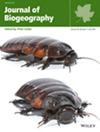Using fossil records to predict short-term changes in niche and spatial dynamics in a broadly distributed coral reef: Niche conservatism and adaptation
Abstract
Aim
Given the rapid pace of climate change and its significant impact on species distribution and survival, understanding the dynamics of ecological niches over time becomes imperative. By employing ecological niche models and species distribution models, alongside analyses of historical occurrence records and palaeoclimatic data, we aimed to assess the extent of changes in the niche of Porites astreoides from the Holocene to the present. Specifically, we quantified the amount of: (1) niche stability, (2) niche expansion, (3) niche decline and (4) niche overlap in both the environmental and geographical space.
Location
Atlantic Ocean.
Taxon
Cnidarian, Scleractinia.
Materials and Methods
Through fossil and current records and environmental variables from the same periods, we use two ecological niche modelling approaches (overlap and maximum entropy) to analyse niche dynamics in environmental and geographical space, specifically the degree of expansion, stability and loss of niches over the last ~8000 years. We used a principal component analysis to build the models within two different calibration areas (minimum convex polygon and buffer).
Results
Our results were similar, except for the loss of habitat, across the calibration areas used to build the models. The PCA used to build the models accounts for more than 65% of the variation in the data. Most of the environmental niche remained stable with an increase of almost a third and a negligible loss. Models in geographical space showed that most of the suitable area remained stable, but the species expanded its range from the Caribbean to the coast of Brazil. The analysis also showed a high value of niche overlap in environmental and geographical spaces.
Main Conclusions
The species studied is one of the corals with the greatest capacity to adapt to new environments and locations, but it also has a high tendency to preserve niche traits. These characteristics helped the species to expand its environmental and geographical niche in a period of relative climatic stability. On the other hand, these same characteristics of niche conservatism can lead the species to population decline and habitat loss, if the speed of adaptation is lower than the rapid climate changes predicted for the middle and end of the 21st century.

 求助内容:
求助内容: 应助结果提醒方式:
应助结果提醒方式:


